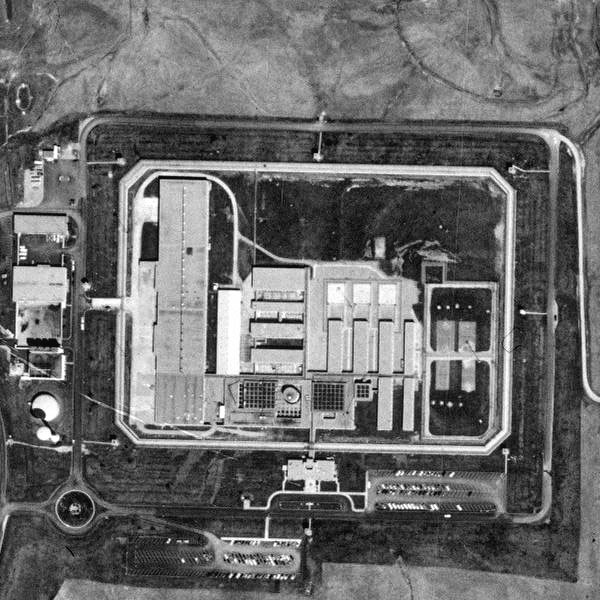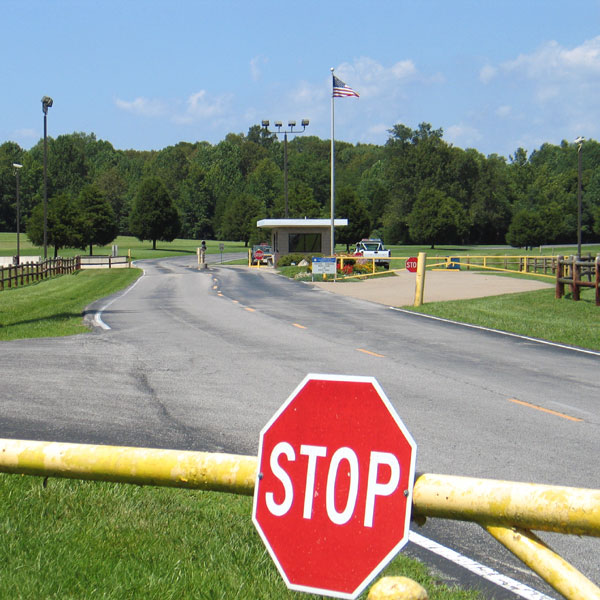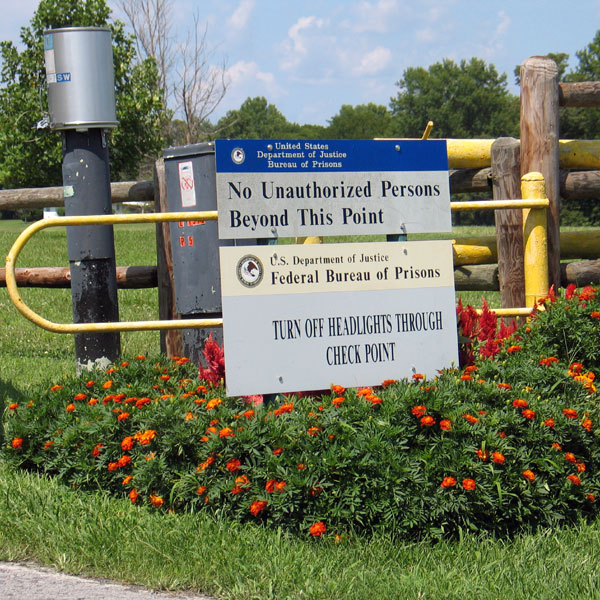
U.S. Census Bureau / Demographics
TerraServer / Aerial Photo
Marion, IL / Community Profile / Current News
Prison Talk / Illinois Forum
{{ USP Marion / Federal Bureau of Prisons }}
U.S. PENITENTIARY
4500 PRISON ROAD
MARION, IL 62959
Phone: (618) 964-1441
INMATE NAME & REGISTER NUMBER
USP MARION
U.S. PENITENTIARY
P.O. BOX 1000
MARION, IL 62959
The United States Penitentiary (USP) in Marion, Illinois, is a high security facility housing male inmates. The facility also has an adjacent satellite prison camp that houses minimum security male offenders.
USP Marion is located approximately 9 miles south of the city of Marion, 300 miles from Chicago, and 120 miles from St. Louis, Missouri.

{ Marion Misc }
"Marion's Success Not Confined to Prison" / The Regional Economist
Usually when people hear about Marion, Ill., it has less to do with good news and more to do with bad dudes. This town is, after all, home turf of the federal penitentiary that in 1963 replaced the notorious Alcatraz prison. Today, the Marion prison remains one of two super maximum facilities in the federal system.
But beyond the forbidding - and expanding - walls of the prison is a community that, thanks to several recent successes, is flush with confidence in what it can achieve. The town has carved out its own economic identity and become more than just the exit off Interstate 57 that Southern Illinois University students take on their way to Carbondale. If the new collaborative approach that area officials have taken continues to bear fruit, outsiders may have little reason to ask the kind of question once posed by a Canadian financier, who on a business trip here turned to a local developer and asked, "Could you please tell me where in the hell I am?"
"A Growth Industry"
The Marion penitentiary houses 484 inmates, with an additional 330 serving time at a minimum-security camp elsewhere on the grounds. More than 350 employees work at the prison, with an additional 70 expected to be hired by July, when an expansion to the maximum-security area is completed.
"It's unfortunate, but this is a growth industry," says Kevin Murphy, executive assistant at the prison. "It's a sad commentary, but it's a fact of life."
Inmates at Marion have committed serious crimes. They are sent here after exhibiting destructive behavior at other federal institutions. Prisoners are confined to their solitary cells for more than 20 hours each day and spend an average of three to five years in Marion. Before being allowed to transfer to another prison, they must display a pattern of good behavior.
BY THE NUMBERS
Population > 16,035
Labor Force > 28,839
Unemployment Rate > 4.3%
Per Capita Personal Income > $22,641
Top Five Employers:
School District > 750
U.S. Veterans Administration > 583
Marion Pepsi-Cola Bottling > 450
General Dynamics > 420
Verizon North > 400
NOTES: Statistics for labor force, unemployment rate and per capita personal income include all of Williamson County. Labor force is from 2001. Unemployment rate is from October 2002. Per capita personal income is from 2000.
"From Alcatraz to Marion to Florence - Control Unit Prisons in the United States"
USP Marion, located in rural southern Illinois, opened in 1963, the same year the federal prison at Alcatraz closed. Alcatraz had gained a reputation as the "end of the line," the federal system's most repressive prison. Prominent gangsters, such as Al Capone, and Robert Stroud, the famous "Bird-Man," were imprisoned there, as were celebrated political prisoners like Rafael Cancel Miranda, the Puerto Rican National Hero, and Morton Sobell, co-defendant with Ethel and Julius Rosenberg. However, the brutality of conditions at Alcatraz proved too controversial in an era when prisons were supposedly committed to the rehabilitation of prisoners.
Marion was constructed to hold 500 "adult male felons who are difficult to control," according to Congressional testimony in 1971 by George Pickett, then superintendent of Marion. Nonetheless, Alcatraz's prisoners were not transferred directly to Marion. Presumably, the BOP considered that the move might spark off significant protest and they wanted to test out the new facility before sending the most politicized prisoners there. Not until the late 1960's were some of Alcatraz's former prisoners transferred to Marion. At about the same time, Marion began its transformation into the new end of the line, a true heir to Alcatraz in its barbaric treatment of prisoners.
In two separate incidents on October 22, 1983, two guards were killed by prisoners in the Control Unit. Although no rebellion resulted and the prisoners responsible were identified, prison officials seized the opportunity to violently repress all prisoners and implement their 1981 plans. The "lockdown," or cell-confinement of all prisoners, was imposed on October 27, 1983. The next day, the warden declared a state of emergency. Sixty guards, including specially trained Special Operations Response Team (SORT) members, were transferred to Marion from other institutions to assist in the lockdown. In addition, eight BOP executive staff members and three senior wardens were sent to "monitor" the procedure. A guard at the time, David Hale, recalls how a Marion official, evidently uninhibited by the team of outside monitors, set the tone for the ensuing shakedown:
"I seen them carry one inmate down the corridor with a guard on each leg and one on each arm. The assistant warden comes down the hall and grabs the inmate's testicles and starts yanking on them, saying, 'Who's doing it to who now, boy?' Well that was a signal for every guard in the place to do whatever the hell he wanted. I can't describe it to you - I never seen beatings like that. At least fifty guys got it, maybe more."
Established as the Federal Bureau of Prisons Long Term Control Unit, USP Marion is one of two "Super Maximum Security" Prisons in the United States. Filled with problem prisoners, violent felons and custody incorrigables, USP Marion has long been known as the 'end-of-the-line' for Prisoners who are unable to function within the confines of traditional prison environments.
In March 2004, USP Marion brought in its first order of Rapid-Cuffs from RRB Systems International. These cuffs are designed to protect prisoners and CO's by limiting prisoner movement, significantly reducing the opportunity for resistance, and preventing escape from the handcuffs. The solid center makes the two opposing cuffs rigid and prevents the prisoner from resisting, or using the cuffs as a tool or weapon.The center piece is forged with a built in "black-box" for further restraining prisoners as necesary.
USP Marion provides an intensive training course for its members who use the Rapid-Cuff.
"We are thrilled at the prospect of being able to put our Rapid-Cuffs and training method to the ultimate test in the ultimate Prison environment," said RRB Systems President Roy Bedard.
"The Continuing Crime of Black Imprisonment"
"Supermax Prisons: High-Tech Dungeons and Modern-Day Torture" / Criminal Injustice
"Held Incommunicado: Statement to the Human Rights Conference on Torture"

{ Prison Resources }
PRISON TALK // FACILITIES // ESSAYS // ORGANIZATIONS //
PRISON-INDUSTRIAL-COMPLEX // IN THE NEWS // BOOKS & PEOPLE //
AUDIO // COLLECTIONS OF PRISON LINKS // LEGAL RESOURCES //
GOVERNMENT & STATISTICS // MISC
{ PRISON TALK }
Prison Talk >> Prisoner Family Support, Information & Assistance >> General Forums
Illinois Forum >> Illinois Prison Profiles / Illinois News & Events / Illinois DOC - What You Need to Know / Illinois Prison Visitation / Illinois Prison Phones, Packages & Mail / Illinois Prisons Lockdown Status Watch
{ ESSAYS / PRISONS IN ILLINOIS }
"The Color and Geography of Prison Growth in Illinois" / by Paul Street
"Starve the Racist Prison Beast" / by Paul Street
"Race, Place, and the Perils of Prisonomics" / by Paul Street
"The Political Consequences Of Racist Felony Disenfranchisement" / by Paul Street
"Census dollars bring bounty to prison towns" / The Chicago Reporter
"Prisons and Southern Illinois" / Illinois Labor Market Review
"Throughout Southern Illinois: Mines Move Out as Prisons Move In" / Illinois Labor Market Review
"Hard Time" / Illinois Issues
"Scrutinizing the Supermax" / SIUC Perspectives
"A SORRY EXCUSE FOR A DECENT LIVING: How Rural Illinois Has Staked its Revival on Prison Growth" / The Next American City
"Drugs and Disparity: The Racial Impact of Illinois' Practice of Transferring Young Drug Offenders to Adult Court"
"Jail Overcrowding and Understaffing" / Chicago Tribune
"Maximum Insecurity: Illinois Prisons in Crisis" / AFSCME Council 31 / January 2006
"Failing Grade: The decline in educational opportunities for Illinois prison inmates" / Campaign for Responsible Priorities
Chicago Urban League / Research & Planning Department
"The Vicious Circle: Race, Prison, Jobs, and Community in Chicago, Illinois and the Nation" / Chicago Urban League
"A Portrait of Prisoner Reentry in Illinois" / The Justice Policy Center